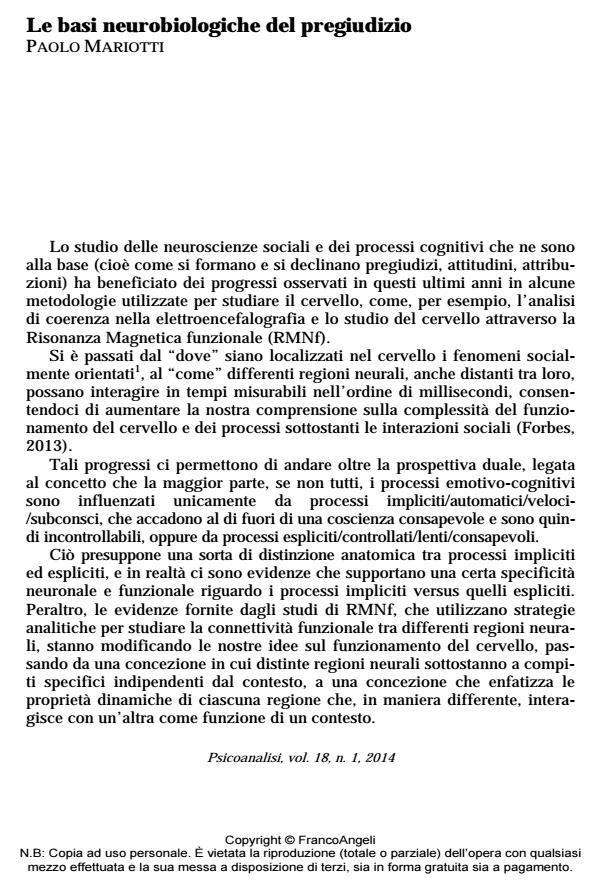Le basi neurobiologiche del pregiudizio
Journal title PSICOANALISI
Author/s Paolo Mariotti
Publishing Year 2014 Issue 2014/1 Language Italian
Pages 8 P. 49-56 File size 53 KB
DOI 10.3280/PSI2014-001005
DOI is like a bar code for intellectual property: to have more infomation
click here
Below, you can see the article first page
If you want to buy this article in PDF format, you can do it, following the instructions to buy download credits

FrancoAngeli is member of Publishers International Linking Association, Inc (PILA), a not-for-profit association which run the CrossRef service enabling links to and from online scholarly content.
- Amodio D. M., Lieberman M. D. (2009). Pictures in our heads: Contributions of fMRI to the study of prejudice and stereotyping. In: Nelson T, ed., Handbook of prejudice, stereotyping, and discrimination. New York: Earlbaum, pp. 347-366.
- Amodio D. M. (2009). Intergroup anxiety effects on the control of racial stereotypes: A psychoneuroendocrine analysis. J. of Exp. Soc. Psychol., 45: 60-67.
- Amodio D. M., Kubota J. T., Harmon-Jones E., Devine P. G. (2006). Alternative mechanisms
- for regulating racial responses according to internal vs external cues. Soc. Cog. Affect. Neurosci., 1: 26-36. DOI: 10.1093/scan/nsl002
- Amodio, D. M. et al. (2004). Neural signals for the detection of unintentional race bias. Psychol.
- Sci., 15: 88-93.
- Beer J. S., Stallen M., Lombardo M. V., Gonsalkorale K., Cunningham W. A. et al. (2008)
- The Quadruple Process model approach to examining the neural underpinnings of prejudice. Neuroimage, 43: 775-783.
- Bijleveld E., Scheepers D., Ellemers N. (2012). The cortisol response to anticipated intergroup interactions predicts self-reported prejudice. PLoS ONE, 7 (3): e33681. DOI: 10.1371/journal.pone.0033681
- Bodenhausen G.V., Macrae C. N., Milne A. B. (Mahwah, 1998). Disregarding social stereotypes: implications for memory, judgment and behavior. In: Golding J. M., MacLeod C. M. eds., Intentional Forgetting: Interdisciplinary Approaches. Mahwah, pp. 349-368.
- Botvinick M. M., Braver T. S., Barch D. M., Carter C. S., Cohen J. D. (2001). Conflict monitoring and cognitive control. Psychol. Rev., 108: 624-652.
- Cunningham, W. A., Johnson M. K., Raye C. L., Gatenby J. C., Gore J. C., Banaji M. R. (2004). Separable neural components in the processing of black and white faces. Psychol. Sci., 15, 12: 806-813. DOI: 10.1111/j.0956-7976.2004.00760.
- Forbes C. E, Grafman J. (2013). Social neuroscience: the second phase. Front Hum. Neurosci., 6: 7-20. DOI: 10.3389/fnhum.2013.00020
- Forbes C. E., Cox C. L., Schmader T., Ryan L. (2012). Negative stereotype activation alters interaction between neural correlates of arousal, inhibition and cognitive control. Soc. Cogn. Affect. Neurosci., 7: 771-781. DOI: 10.3389/fnhum.2013.00560
- Hartley C. A., Phelps E. A. (2010). Changing fear: the neurocircuitry of emotion regulation.
- Neuropsychopharmacology, 35: 136-146. Kubota J. T., Banaji M. R., Phelps E. A. (2012). The neuroscience of race. Nat. Neurosci., 15, 940-948. doi 10.1038/nn.3136
- Olsson A., Nearing K. I., Phelps E. A. (2007). Learning fears by observing others: the neural systems of social fear transmission. Soc. Cogn. Affect. Neurosci., 2: 3-11.
- Phelps E. A., LeDoux J. E. (2005). Contributions of the amygdala to emotion processing: from animal models to human behavior. Neuron., 48: 175-187.
- Stanley D., Phelps E. A., Banaji M. R. (2008). The neural basis of implicit attitudes. Perspect. Psychol. Sci., 17: 164-170.
Paolo Mariotti, Le basi neurobiologiche del pregiudizio in "PSICOANALISI" 1/2014, pp 49-56, DOI: 10.3280/PSI2014-001005